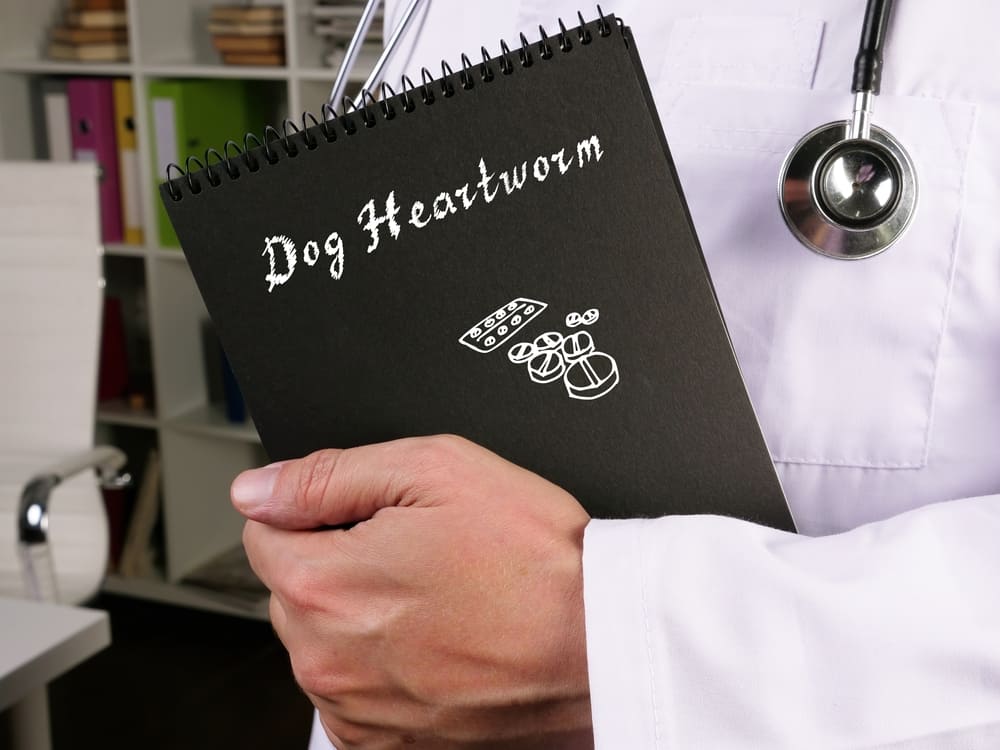Here’s a detailed description of heartworm disease in dogs, covering diagnosis, treatment, and the life expectancy question. Also included are key takeaways for dog owners.
Heartworm Disease in Dogs: A Serious Threat
Heartworm disease (also called dirofilariasis) is a potentially fatal condition caused by parasitic worms ( Dirofilaria immitis) that live in a dog’s heart, lungs, and associated blood vessels. Transmitted through mosquito bites, heartworms can significantly damage vital organs if left untreated.
Understanding the Threat
- Transmission: Dogs are infected when a mosquito carrying heartworm larvae bites them.
- Development: Larvae take 6-7 months to fully mature into adult heartworms within the dog’s body.
- Reproduction: Adult females release offspring (microfilariae) into the bloodstream.
- Severity: The degree of damage depends on the number of worms, their location, and how long they’ve lived in the dog.
Symptoms: The Hidden Danger
Early stages often have no obvious signs. As the disease progresses, these symptoms may appear:
- Persistent cough
- Difficulty breathing
- Fatigue and weakness
- Weight loss
- Swollen abdomen (due to fluid buildup)
- Fainting spells
- In severe cases, rapid collapse and death
Diagnosis: Uncovering the Problem
Vets diagnose heartworm disease through a combination of:
- Symptom review: Understanding the dog’s history and current health.
- Blood tests: Detect the presence of heartworm proteins or microfilariae.
- Imaging: X-rays and ultrasounds assess heart and lung damage.
Treatment: A Complex Process
Treating heartworm disease is challenging and carries risks. Here’s what it entails:
- Eliminating Adult Worms (Adulticide): Specific medication (like Immiticide) is given in a careful, staged process due to the danger of dead worms causing blockages.
- Treating Microfilariae: Additional medication prevents further spread.
- Supportive Care: Addressing heart and lung damage, plus controlling inflammation.
- Surgical Removal: Sometimes necessary for severe blockages.
Life Expectancy After Treatment: It Depends
- Severity: Early detection and less damage mean a better prognosis.
- Overall Health: Strong dogs with no other conditions fare better.
- Treatment Success: Complete elimination of heartworms is the goal.
- With mild cases caught early, dogs can often live a full, healthy life after treatment.
- Severe infestations carry a greater risk of complications and shortened lifespan.
The Importance of Prevention
Protecting your dog is far easier and safer than treatment:
- Preventive Medications: Monthly pills, injections, or topicals effectively kill heartworm larvae before they become adults.
- Mosquito Control: Limit exposure to bites where possible.
Key Takeaways for Dog Owners
- Heartworm disease poses a serious, even fatal, risk to dogs.
- Early symptoms are subtle, so routine vet checkups are vital.
- Treatment is complex, costly, and can be risky.
- Year-round prevention is the best way to protect your dog.
- If your dog is diagnosed, work closely with your vet to give them the best chance of recovery.
Dog Life Expectancy After Heartworm Treatment:
The likelihood of a dog surviving after heartworm therapy relies on the extent of the damage, the dog’s response to the medication, and the dog’s general health. In general, dogs with heartworm disease who are asymptomatic can have a long, healthy life devoid of symptoms following treatment.
After infection, a dog can live for at least six to seven months. Depending on how severe the issue is, a dog may be able to survive for a while without medical attention. The answer, however, is more complicated.
What Causes Heartworm in Dogs?
In dogs, heartworm is a dangerous and sometimes fatal condition. Dirofilaria immitis is the parasite that causes canine heartworm disease.
When a dog gets bitten by a mosquito carrying tiny heartworm larvae, heartworm illness develops. Through the biting wound, the larvae go into the dog’s circulation. After this, it may take the larvae six to seven months to mature into adult heartworms.
Heartworms can only reproduce after they are fully grown. The females then release more juvenile heartworms into the bloodstream of your dog as a result. Unfortunately, this promotes the disease’s rapid spread and increases its symptoms.
As was already noted, the illness has four stages, each of which has a different set of symptoms and varying degrees of severity.
The majority of canines should survive at least six months after infection, according to expectations. This is due to the fact that most symptoms do not manifest until the heartworms are completely grown.
However, the dog is more vulnerable to Caval syndrome and its lethal symptoms once the adult heartworms have completed their life cycle and begun to proliferate.
What is the Life Cycle of a Heartworm?
Adult heartworms are found in the heart and adjacent large blood vessels of infected dogs. Rarely, parasites can be found in other parts of the circulatory system. The female of this worm has a length of 15 – 36 cm and a width (about 0.5-1 mm). When conducting a pathological diagnosis, up to 300 worms can be found in one dog.
A dog’s body can harbor adult heartworms for up to five years. Heartworm adults have a maximum lifespan of five years, during which the female worm gives birth to millions of microfilariae, her offspring. The majority of these microfilariae’s habitat is tiny blood arteries.
What Happens When A Dog Is Infected With Heartworm?
The disease proceeds hidden for a long time. This period usually takes several years before the dog shows clinical signs of infestation.
Consequently, the disease is diagnosed mainly in dogs between two and eight years of age. The disease rarely occurs in dogs less than one year of age because the development time from microfilaria to microfilaria takes five to seven months after infection.
By the time clinical signs are visible, the disease is at a very serious stage. Adult heartworms cause disease by blocking the heart and large blood vessels leading from the heart.
They also interfere with the normal functioning of the valves in the heart. By clogging the main blood vessel, the blood supply to other organs of the body is reduced, especially the blood flow to the lungs, liver, and kidneys, which leads to disruptions in the functioning of these organs.
Development of Heartworm In Dogs:
Heartworms in dogs cause a variety of symptoms, as the effects of these worms on the host are varied.
First of all, both microfilariae in the bloodstream and adult worms in the heart of dogs have an irritating mechanical effect on the vessels and walls of the heart, which leads to blockage of blood vessels and inflammation of the cardiac membranes.
Dog heartworms feed on the host’s blood, causing blood loss, and the metabolic products they secrete have a toxic effect. When helminths die and a large number of decay products of their tissues are released, the toxic effect on the animal’s body increases.
During the acute course of the disease, allergic reactions become significant. The main indicator of the development of allergies is an increase in the number of eosinophils in the blood.
There is also an active development of mast cells that secrete hormones, the action of which, due to a chain of reactions, ultimately boils down to stagnation of blood in the capillaries, swelling of tissues, and thickening of the blood. Tachycardia also develops and blood pressure rises.
Heartworms in dogs also have a profound effect on the immune system. The foreign body of the helminth is forced to overcome the forces of rejection from the body. To do this, parasites secrete immunosuppressants that reduce the animal’s immunity.
Symptoms A Dog Is Infected With Heartworm:
The presence of heartworms in dogs causes changes to the heart and lungs. The larvae (microfilariae) cause as many problems as the adult worms themselves.
Depending on the areas of the heart and lungs contaminated, different symptoms may appear. The most common are the following:
- General weakness;
- Cough (chronic);
- Shortness of breath/shortness of breath (dyspnea);
- Abnormal lung sounds;
- Loss of consciousness (syncope).
A massive worm infestation can lead to right heart failure. This dysfunction can in turn cause other problems, such as liver congestion (hepatomegaly), dropsy (ascites), and fluid retention (edema).
If the disease progresses poorly, heart failure results in serious circulatory disorders (vena cava syndrome). The death of the animal often occurs within 24 to 72 hours. Symptoms can appear suddenly and take the following forms:
- State of deep lethargy;
- Weakness;
- Pale mucous membranes;
- Particularly fast heart rate (tachycardia attacks) and increased respiratory rate (tachypnea);
- Weak pulse;
- Blood in the urine (hemoglobinuria);
- Anemia (hemolytic anemia);
- Liver and kidney failure.
Diagnosis of Heartworm In Dogs:
As with any other disease, the diagnosis of dirofilariasis is made taking into account a set of symptoms, medical history, as well as laboratory and radiographic data. Sometimes electrocardiography and echocardiography methods are also used.
If there are a large number of microfilariae in the blood, a laboratory technician can also detect them during a general blood test, simply by seeing them under a microscope. This is the so-called direct method.
However, when conducting a special analysis for dirofilariasis in modern laboratories, various concentration methods are used, which can show the presence of heartworms in a dog even with a small concentration of microfilariae, and even determine their type.
There are also immunological methods that show the presence of antibodies to heartworms or the antigen itself in the blood.
The methods of radiography, ECG, and echoCG are indirect: they do not allow one to see the worms themselves in the dog’s heart, but they can detect thickening of the pulmonary artery, enlargement of the right half of the heart, darkening in the lungs, and functional disorders of the heart.
An indirect symptom of the presence of heartworms in a dog may, again, be an increase in the number of eosinophils in the blood.
Treatment of heartworms in dogs
Treatment methods are divided into medicinal and surgical. Know more about this in detail.
Drug Therapy:
The degree of infestation is preliminarily determined. Treatment methods for the disease vary. If instrumental studies do not detect a helminth, the clinical symptoms are erased, it is possible to put the animal in a cage and destroy the parasites (adulticide).
At the same time, it is necessary to conduct additional studies on chronic diseases in which the use of a drug that eliminates heartworm is contraindicated.
Adulticide: Immiticide (Melasormin) is considered an effective helminth destroyer. It is an organometallic compound of arsenic.
The drug is administered intramuscularly, and the dog is placed in a cage for a month. After 30–90 days, Melasormin is reapplied. After 24 hours the injection is repeated. The pet is again kept in a cage for two months.
The blood is tested for microfilariae every 30 days. If six months after the last injection no larvae are found, the dog is considered recovered.
In addition, they destroy the symbiotic microflora, without which the larvae die. Doxycycline is effective.
Before prescribing an anti-dirofilariasis drug, it is necessary to find out whether the pet has diseases for which such treatment is contraindicated. If heartworms are detected by radiographic or echocardiographic methods, cardiac and pulmonary pathologies must be eliminated before administering adulticide. Further treatment is the same as for a low degree of infestation.
Adjuvant Therapy:
Mandatory for all treatment methods. Corticosteroids are used, which have an anti-inflammatory effect, as well as heparin, which prevents blood clots.
Surgical Treatment:
To save a pet in the event of a severe venous circulation disorder, the veterinarian has no more than 48 hours. Before and after the operation, auxiliary treatment is carried out. Helminths are extracted from the atrium and vena cava.
The alternative method of removing parasites from the pulmonary arteries is difficult and dangerous. After the operation, adulticide is administered.
How To Protect Our Dog From Heartworm?
To avoid this and limit the risks of contamination, it is necessary to take a certain number of precautions to protect dogs living in a region at risk or traveling there:
- By limiting mosquito bites, thanks to specific repellent products, in pipettes and necklaces. Ask your veterinarian to prescribe the product best suited to your pet. However, be wary, that protection is limited, and it is preferable to also give preventive medical treatment.
- By giving preventive medical treatment, which destroys the larvae (transmitted by mosquitoes) before they become adults. In pipettes or tablets, these medications should be administered as prescribed by your veterinarian. If the animal lives permanently in a risk area, it is recommended to treat it once a month from May until November. If it is a dog going on vacation to a risk area, it must be treated every month during its stay, and again upon return.
Conclusion:
It is very difficult to treat animals once the worms have matured. If the worms die en masse, a very serious state of shock can block the blood vessels and can cause the death of the animal. It is therefore important to carry out the treatment gradually over several months. There are effective drug treatments against adult worms and their larvae for dogs.








